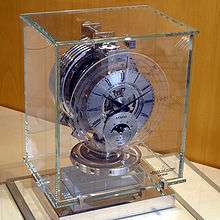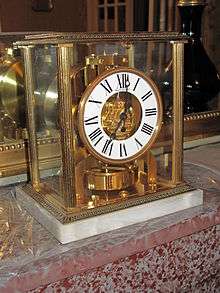Atmos clock
Atmos is the brand name of a mechanical torsion pendulum clock manufactured by Jaeger-LeCoultre in Switzerland which does not need to be wound manually. It gets the energy it needs to run from temperature and atmospheric pressure changes in the environment, and can run for years without human intervention.

The clock is driven by a mainspring, which is wound by the expansion and contraction of liquid and gaseous ethyl chloride in an internal hermetically sealed bellows. The ethyl chloride vaporises into an expansion chamber as the temperature rises, compressing a spiral spring; with a fall in temperature the gas condenses and the spring slackens.[1] This motion constantly winds the mainspring. A temperature variation of only one degree in the range between 15 °C (59 °F) and 30 °C (86 °F), or a pressure variation of 3 mmHg, is sufficient for two days' operation.[2]
In order to run the clock on this small amount of energy, everything inside the Atmos has to work in as friction-free a manner as possible. For timekeeping it uses a torsion pendulum, which consumes less energy than an ordinary pendulum. The torsion pendulum has a period of precisely one minute; thirty seconds to rotate in one direction and thirty seconds to return to the starting position. This is thirty times slower than the 0.994 m (39.1 in) seconds pendulum typically found in a longcase clock, where each swing (or half-period) takes one second.
History

The first clock powered by changes in atmospheric pressure and temperature was invented by Cornelis Drebbel in the early seventeenth century. Drebbel built as many as 18 of these, the two most notable being for King James VI & I of Britain, and Rudolf II of Bohemia. The King James clock was known as the Eltham Perpetuum, and was famous throughout Europe. It is mentioned in two works of Ben Jonson.
Clocks powered by atmospheric pressure and temperature changes were subsequently developed by Pierre de Rivaz in 1740,[2] and by James Cox and John Joseph Merlin (Cox's timepiece) in the 1760s. The Beverly Clock in Dunedin, New Zealand, is still running despite never having been manually wound since its construction in 1864.
The first Atmos clock was designed by Jean-Léon Reutter, an engineer in Neuchâtel, Switzerland, in 1928.[3][4][5] This noncommercial prototype, which predated the Atmos name but is now known unofficially as Atmos 0, was driven by a mercury-in-glass expansion device. The mechanism operated on temperature changes alone.[6][3][4]
On 1 June 1929, Compagnie Générale de Radio (CGR) in France began manufacturing the first commercial model, Atmos 1, which used a mercury and ammonia bellows power source. On 27 July 1935, Jaeger-LeCoultre took over production of Atmos 1 while it developed a second design which used the present ethyl chloride power source. This model later named the Atmos 2, was announced on 15 January 1936, but problems delayed full production until mid-1939. Subsequent models were based on this design. To date, over 500,000 Atmos clocks have been produced.[2]
See also
References
| Wikimedia Commons has media related to Jaeger-LeCoultre Atmos. |
- Sacks, Adam Michael (22 April 2007), "How the Atmos works", The Atmos Clock Page, Los Angeles: atmosadam.com, retrieved 2007-12-08
- Callaway, Edgar H. (2003). Wireless Sensor Networks: Architectures and Protocols. Boca Raton, FL: CRC Press. pp. 157–158. ISBN 978-0-8493-1823-8.
- Xian, Su Jia (13 January 2014), "Jaeger-LeCoultre Atmos Clock History", DreamChrono, Nassau: DreamChrono.com.
- Neveur, Frédéric (29 December 2016), "Histoire de la pendule Atmos", Atmostime (in French), Mountain View, CA: Google Sites.
- Murray, Michael P. (11 March 2004). "Basic information on the Atmos". Mike's Clock Clinic. Archived from the original on 29 December 2007. Retrieved 2007-12-07.
- Oliver, Richard (4 January 2015), "Atmos LeCoultre History", Antiques Clock Guy, Vista, CA: clockguy.com.